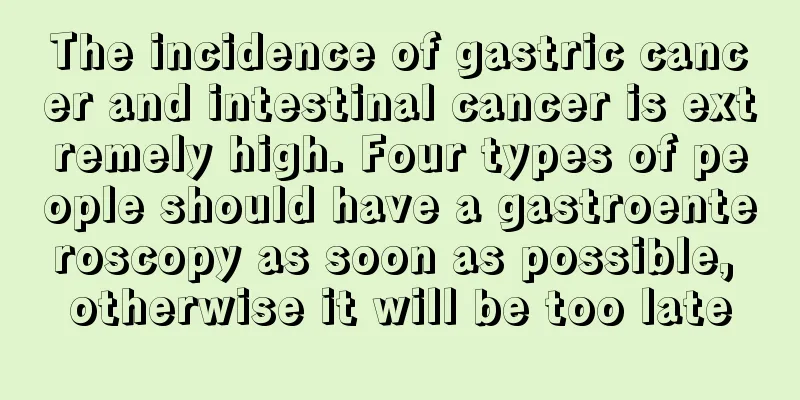The incidence of gastric cancer and intestinal cancer is extremely high. Four types of people should have a gastroenteroscopy as soon as possible, otherwise it will be too late

|
We now find that the incidence of gastric cancer and intestinal cancer is particularly high. We always hear such bad news around us, and most patients will die within a year. So what should we do in our daily lives to detect them in time? What can we do to prevent cancer? Experts emphasize that since early esophageal cancer, early gastric cancer, and early intestinal cancer are generally asymptomatic, some may have inflammation, ulcers, etc., but these are non-specific symptoms and should not be taken lightly. Do not wait until the onset of "alarm symptoms" such as weight loss, vomiting blood, bloody stools, and anemia, which are medically known as "alarm symptoms", before doing an endoscopy. It is often too late at this time and you have missed the opportunity to detect early cancer. Experts remind that the following groups of people need to undergo gastrointestinal endoscopy as soon as possible: The first is the general population over 45 years old. Experts call for everyone over 45 years old, regardless of gender, to undergo a gastrointestinal endoscopy once a year. Second, there is a family history of esophageal cancer, gastric cancer, or intestinal cancer, Helicobacter pylori infection, an unhealthy lifestyle such as smoking and drinking, irregular diet or overeating or eating too much meat and fish, a preference for pickled foods with high nitrate content, high work pressure, and frequent staying up late, which can lead to a disrupted biological clock and low immunity, etc. Once these people have inducing factors, they can stimulate oncogenes and lead to gastrointestinal cancer. The third group is people who have already experienced digestive tract discomfort, such as stomach discomfort, which can manifest as upper abdominal pain, lower abdominal pain, acid reflux, belching, fullness, etc.; intestinal discomfort, which can manifest as lower abdominal pain, changes in bowel habits and characteristics, such as changing from once a day to multiple times a day, or constipation, loose stools, bloody stools, nasal mucus and blood in the stool, etc. Fourth, if elevated levels of digestive tract tumor markers such as CEA and CA199 are found during a normal physical examination, a gastroenteroscopy should be performed as soon as possible for further screening. Gastroscopy precautions 1. Do not smoke the day before to avoid intubation caused by coughing during the examination. Quitting smoking can also reduce gastric acid secretion, making it easier for doctors to observe. 2. Do not eat or drink water for at least 8 hours before the examination. Food in the stomach can easily affect the doctor's diagnosis and induce nausea and vomiting in the subject. 3. The patient must fast for at least 6 hours before the examination. If the examination is conducted in the morning, you should fast after dinner the day before and skip breakfast on that day. If the examination is conducted in the afternoon, you can eat light semi-liquid food for breakfast and fast at noon. 4. For patients with severe illness or weak constitution who have difficulty supporting themselves after fasting, hypertonic glucose solution should be injected intravenously before the examination. 5. In order to eliminate the patient's nervousness, reduce gastric juice secretion and gastric motility, expel the foam in the stomach, and make the image clearer, the doctor should give the patient sedatives, antispasmodics and defoaming agents 20-30 minutes before the examination if necessary. 6. In order to reduce throat discomfort, medical staff will spray anesthetic on the patient's throat 3 minutes before the examination. Patients should understand this and cooperate with it. 7. In order to allow the gastroscope to pass through the pharynx smoothly, medication is generally required before gastroscopy. Before taking any medication, tell your doctor your history of drug allergies, that is, what drugs you were allergic to in the past. 8. Local analgesia is used for pain relief, limited to the throat and upper esophagus. Local analgesia is achieved by spraying 2% dicaine or 2% xylocaine. The patient opens his mouth and makes an "ah" sound. The soft palate and palatoglossal arch move up, and the root of the tongue moves down, so that the back of the tongue, throat, and soft palate are sprayed with the medicine. This is repeated three times. After each spray, the patient swallows the remaining medicine in the mouth to relieve pain. 9. You can also use paste, hold it in your mouth and tilt your head back so that the medicine stays in the throat and flows naturally into the esophagus, which has a local analgesic effect. 10. The patient and the doctor should cooperate. Before the examination, the patient should go to urinate to empty the bladder. After entering the examination room, the patient should loosen the collar and belt, take off dentures and glasses, lie on the left side, or change to other positions as needed. Colonoscopy precautions 1. Indications: 1. Unexplained lower gastrointestinal bleeding, including persistent occult blood or obvious bleeding. 2. Follow-up after colorectal polypectomy, follow-up after colorectal cancer surgery, follow-up for drug efficacy observation, and regular cancer prevention follow-up for certain precancerous lesions. 3. Unexplained weight loss, difficulty in defecation, change in bowel habits, tenesmus, abdominal pain, mucus and blood in the stool, chronic diarrhea, constipation, anemia, and fatigue. 2. Contraindications: 1. Women should not undergo examinations during menstruation, and should also be cautious during pregnancy. 2. This examination is contraindicated in patients who are suspected of having intestinal fistula, perforation or extensive abdominal adhesions in the early stage after pelvic or abdominal surgery. 3. Patients with symptoms of peritoneal irritation, such as peritonitis, intestinal perforation, etc., are contraindicated in undergoing this examination. 4. When the anal canal and rectum are narrow and the colonoscope cannot be inserted, colonoscopy should not be performed. 5. Patients with severe hypertension, old age, anemia, coronary heart disease, cardiopulmonary insufficiency, and coronary heart disease should not undergo examination. 6. Avoid examination if there are painful lesions or acute infections in the anorectal canal, such as perianal abscesses, anal fissures, etc. |
<<: Flood hits Xingtai, Hebei, killing many people, officials kneel down to "seek understanding"
>>: A type of needle hole on the body turns out to be a deadly cancer
Recommend
What's going on when platelets continue to decrease?
Platelets are relatively important substances in ...
How does the pathology of nasopharyngeal carcinoma change
In recent years, nasopharyngeal carcinoma has bec...
What to do if thyroid cancer causes unstable blood pressure
Thyroid cancer can cause unstable blood pressure,...
What should I do if my teeth are concave
If people's teeth are not neat, it will affec...
What are the fastest ways to get rid of acne scars?
People who have been troubled by acne for a long ...
What are the symptoms of nasopharyngeal carcinoma metastasis and how to treat it
What are the symptoms of nasopharyngeal carcinoma...
There is white mucus and blood in the stool
Everyone needs to have normal bowel movements eve...
Is the ceramic casserole poisonous?
Soups cooked in ceramic casseroles taste more del...
How to make delicious chicken soup
Drinking soup is a habit of many people. Nowadays...
Treatment of advanced gallbladder cancer
Gallbladder cancer is a very serious malignant tu...
Is it useful to take Chinese medicine for renal hamartoma? Can it be cured?
Taking Chinese medicine for renal hamartoma may h...
Effective ways to get rid of bad breath
The appearance of bad breath not only makes us fe...
What causes small cell lung cancer
Nowadays, the incidence of small cell lung cancer...
How long can you live if ovarian cancer recurs
Ovarian cancer is often in the late stage when it...
If there is a lump on the tongue, beware of the symptoms of tongue cancer. Eating too hot food can also cause tongue cancer
Tongue cancer is not uncommon. Among oral maligna...









